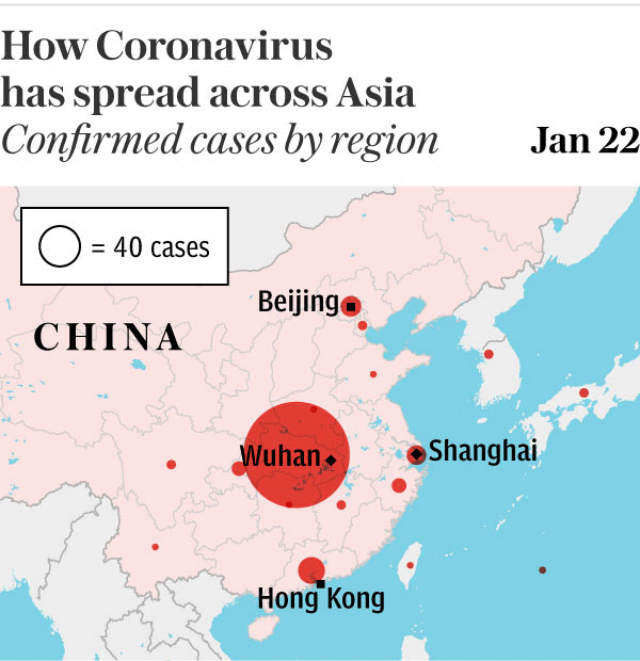Coronavirus infection: everything you need to know about the outbreak from China
A new coronavirus has broken out in China, infecting more than 4,000 people and killing 106. As authorities fight to contain the virus, experts warn that the death toll will almost certainly rise.
The disease, which causes pneumonia-like symptoms, has forced Beijing to quarantine 18 major cities, essentially locking down more than 56 million people.
Here's everything you need to know about the virus.
What is the coronavirus?
Coronaviruses are a family of viruses that cause illnesses ranging from a cold to more severe diseases. Typically, symptoms include a fever, fatigue, sore throat and dry cough, and may later develop into breathing difficulties.
These viruses are transmitted between animals and people. This novel coronavirus, currently named 2019-nCoV, is a new strain that had not been previously identified in humans.
Where and when did the infection start?
The source of the coronavirus is believed to be a seafood market in the central Chinese city of Wuhan. The city's health commission said the infection broke out between December 12 and 29, with some of the patients employed at the market.
The animal source of the outbreak has not been identified but two recent research papers have pointed to bats and snakes as the possible culprits.
The market in Wuhan, now shut down, was home to stalls trading in many different animals, including snakes, marmots and poultry. These “wet” markets are popular in China as customers like to purchase their meat “warm” - that is, recently slaughtered.
Here's how the virus can spread:
How far has it spread?
While most people affected are in China, cases in this fast-moving outbreak have now been found in the United States, France, Australia, Hong Kong, Thailand, Malaysia, South Korea, Taiwan, Macau, Japan and the Philippines. Fourteen people are being tested in the United Kingdom.

How quickly has it spread?
Since the outbreak in mid-December, cases have escalated at pace. Within a month, two people in China had died while about 40 cases were identified. As of January 27, the death toll stood at 82 with more than 2,700 cases.
The city of Macau, a gambling hub hugely popular with mainland tourists, has confirmed five cases as of Sunday. In Hong Kong, six people are known to have the disease and Taiwan has uncovered five cases so far.
As of January 27, the virus has continued to spread internationally, with the United States recording five confirmed cases. and Canada confirming its first case.
Singapore has five while Nepal has identified its first, Thailand its eighth and Cambodia has one. Sri Lanka confirmed its first case of the virus on Monday
Elsewhere in Asia, Taiwan has uncovered four cases so far, South Korean media reported the country's forth case, and Vietnam confirmed two cases. Malaysia and Japan have both confirmed four cases.
Australia has confirmed it has five confirmed cases of the virus.
In Europe, France has confirmed three cases while Germany has recorded one case so far.
Despite the speed and spread of the virus, experts have been surprised that the World Health Organisation (WHO) has not declared a global health crisis, which would see emergency measures put in place. The organisation said it was “too early” to do so.

How many people are infected?
Currently, there are more than 4,000 known cases.
How many people have died?
At least 106 people have died. Most experts expect this number to rise and there is concern that China is not being honest about the spread and potential impact of the virus.
Is there a vaccine?
No. And some pharmaceutical experts have warned that a vaccine could be years in the making. Beijing was quick to share what it knew about the virus's genetic code, which means researchers in the US and China have already begun working on a vaccine. However, any vaccine may not be available for up to a year and priority would go to health workers most at risk of contracting the virus.
Professor Robin Shattock, from Imperial College London, said his team had “two vaccine candidates” developed from the genetic sequence of coronavirus provided by Chinese scientists, and some British experts are confident that a vaccine could be available within weeks.
Prof Shattock told Radio 4’s Today programme the vaccines would be ready for use in “animal models” by the middle of next month and they were ready to “rapidly move those into human studies” if required.
For now, it is a case of containment. China has started building a hospital to treat only patients with the virus which it hopes to finish within days.
Is this virus like Sars?
Yes and no. Like all the devastating disease outbreaks of recent years, including HIV and Ebola, coronaviruses emerge from animals – in the case of Sars (severe acute respiratory syndrome) the disease jumped from bats to civet cats, a delicacy in parts of China, to humans. And in Mers (Middle East respiratory syndrome) the disease leaped from bats to camels to humans.
Sars, first reported in China in 2002, spread to 27 countries, infecting around 8,000 people and killing 700. It spread quickly but then appeared to run itself out.
Mers on the other hand, is more tenacious. It first emerged in 2012 in Jordan and about 2,500 cases of the disease have been identified so far. It is more deadly than Sars, and has claimed about 850 lives in total.
Like Sars, and unlike Mers, this coronavirus presents symptoms which make it easier to identify.
There is no vaccine for Sars or Mers that is both safe and effective in humans.
China is keen to avoid the international anger it provoked in its slow response to Sars. At the time it was accused of covering up the outbreak.
Is the virus in the UK?
The NHS has said that of at least 2,000 people suspected in recent weeks to have travelled to the UK from Wuhan, the Chinese city at the centre of the outbreak, only 52 have been tested for coronavirus. All have returned negative results.

Protect yourself and your family by learning more about Global Health Security. And sign up to our weekly newsletter here.

 Yahoo News
Yahoo News 
